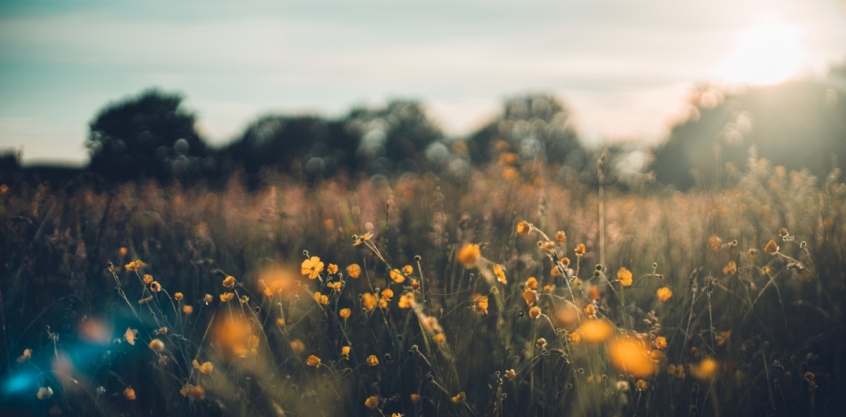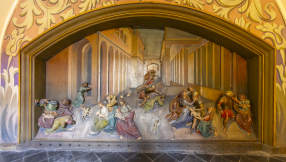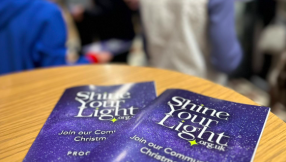
Jewish academic and Hebrew scholar Irene Lancaster reflects on how the key Jewish concept of Shemitta (Sabbath of the Land) and Jubilee can reboot the world and set us all free.
Nearly 20 years ago I was invited by Cambridge University to launch my book about the great Spanish Jewish biblical exegete, Abraham ibn Ezra (1089-1164). That's where I first met Rabbi Yedidya Sinclair, the Jewish chaplain, who lectured in the university's Divinity School. During my stay at Cambridge University, Rabbi Yedidya organized kosher food and told me about his vision.
This vision was two-fold: to live in Israel and to protect the environment. The first vision I understood – the second not quite as much. But for Rabbi Yedidya the two went together. He was definitely a person before his time.
Fast forward almost 20 years and Rabbi Yedidya now lives in Jerusalem and has produced a beautiful translation and commentary on the most major work on the environment, based in biblical sources, that has ever been written. Rabbi Yedidya is well qualified to do this. He studied at Oxford University, and then at Harvard. He obtained rabbinic semicha (ordination) and also acted as economic adviser to the British government. Rabbi Yedidya has more recently advised third world countries on solar energy and other environmental issues.
Most recently of all, Rabbi Yedidya has joined fellow Jewish rabbis, economists, architects, Holocaust survivors, refugees, writers, musicians, poets, historians and scholars in signing our petition, asking the British government to rethink its desire to destroy a tiny park in Westminster, called Victoria Tower Gardens.
There are very good reasons for preserving our remaining green spaces. During this country's recent four-day Platinum Jubilee celebrations, the Royal Family insisted that our future depends on how we treat our own planet. The idea of constructing an ugly edifice to the Holocaust in a tiny park, ostensibly 'so that it will never happen again', sits ill in the face of all the evidence to the contrary. Destroying the fabric of Heritage Park, Victoria Tower Gardens - one of London's tiniest parks - in order to 'make a statement', simply doesn't seem honourable.
This country finds herself in dire circumstances and the talk from Government is now about preservation, not destruction. Terrorist attacks and flooding are two very real threats to the enterprise, but despite this palpable menace to life and limb, the Government and her allies have simply closed their ears to our pleas and refused to take note.
This article by Rabbi Yedidya might go some way to explaining why the present Prime Minister and Secretary of State for 'Levelling Up' have not even acknowledged our letters, sent on behalf of Holocaust survivors and their families, including myself, who regard the entire project as a gross insult to our exterminated families.
By signing our petition and helping us to work towards preventing the destruction of the lived environment at the heart of London, Rabbi Yedidya is truly a disciple of the great Rav Kook, whose own seminal work on the environment, Sabbath of the Land, he has just translated.
For Rav Kook (1865-1935), originally from a small hamlet in Latvia, as first Chief Rabbi of Israel (under the British Mandate authorities), petitions and even strike action were part of his toolkit when necessary. Rav Kook spent a few years in London towards the end of World War I, where he waxed lyrical about the Royal Parks. On his daily walks in these calm green spaces, he worked on improving his English through reading Shakespeare and the King James Bible, while attracting support for the 1917 Balfour Declaration, which eventually led to the declaration of the State of Israel at the end of the British Mandate period.
Rabbi Yedidya's translation has been published by Rabbi Jonathan Sacks' publisher, Koren of Jerusalem, with a forward by the world's largest religion-based environmental organization, Hazon, which recently merged with Pearlstone. The Hazon team recently asked me to contribute to their thoughts on the weekly biblical portion, which I did last year just in time for the Climate Change Conference, Cop 26, held in Glasgow, as it happens.
Hazon also invited our Broughton Park Jewish Christian Dialogue Group to partner with them in their Shemitta project. We hosted two Zoom presentations on the concept of Shemitta by Rabbi Yedidya and Nigel Savage (Founder and President of Hazon, and born in this neighbourhood).
The question asked by all these people and organizations is: how can the lessons of Shemitta help us to reset our world such that it is preserved in the face of unknown future crises?
This question also exercised Rav Kook. Rav Kook wrote his famous work on Shemitta in 1909, when he was Chief Rabbi of Jaffa, in the wake of the Russian pogroms, the defeat of Russia in the 1905 Russian-Japanese War, and the increased Aliyah (immigration) of Jews from Russia to the Land of Israel.
In Jewish history, as in others, there are those (probably the majority of those in diaspora) who look back to the 'good old days', and those who look forward to the unknown exciting future, working as partners of G-d in this enterprise. Rav Kook never looked back – he always looked forward. He was friends with the greatest Hebrew poet of the age, Chaim Bialik (1873-1934), later Israel's national poet. They had shared time together at East European Yeshiva (rabbinic seminary), and Bialik had then dropped out, realizing that the future of the Jews was dependent on coming to terms with reality by resetting the rabbinic mindset.
What is the point, Bialik declared in one of his greatest poems, Ha-Matmid ('The Eternal, Fanatical Talmud Student'), of remaining cooped up forever in one of those dull and dismal decrepit yeshiva buildings, when the entire world of nature cries out to you with its own poetry and lore.
In 1903 Bialik had been sent by his community in Odessa to write a report on the Kishinev pogrom which had just taken place in Moldova. Bialik wrote about this government-sponsored massacre in his epic poem, 'The City of Slaughter'.
To Bialik, it wasn't simply the Czar-inspired murderers who were the principal object of his ire. Those could be taken very much for granted as part of Jewish diasporic existence. The very rabbis themselves, products of a Yeshiva such as the one described above, who, faced with the reality of their own wives and daughters being raped and murdered before their very eyes, remained glued to the spot, or simply ran away. The rabbinic world was simply no longer fit for purpose in his eyes.
The average rabbi of that era simply didn't have the psychological tools to deal with anything outside their extremely restricted, pietistic, largely indoor existence. Instead of leading from the front, they were simply bringing up the rear.
Then, as now, the average rabbi often held onto the comfort blanket of the tried and tested old ways, rather than seeing the world for what it is, utilizing the latest discoveries of scientists, medical doctors and other forward-thinking people, for the positive future of humanity. Rav Kook saw this. Our present monarch sees this. Former Archbishop of Canterbury, Lord Williams of Oystermouth, sees this. Rabbi Yedidya sees this. And so does Hazon-Pearlstone. One of our greatest Anglo-Jewish journalists, Melanie Phillips (now spending much of her time in Israel), also sees this uncomfortable truth and has written about it here.
Just before Cop 26, which took place at the end of last year in Glasgow, Lord Williams of Oystermouth asked me to provide him with the three main Jewish environmental references which might benefit a gentile audience. To many, these three would include Rashi's commentary on Genesis 1 (G-d creates the world 'for the sake of the first fruits'); the Levitical Sabbath of the Land (known as the Shemitta year); and the Jubilee year, based on the Hebrew word for 'ram's horn' (yovel), when debts are rescinded and slaves go free.
Not only is there release for the land every seven years, but, every 49 years, liberty and debt release for the poor and needy. And Jubilee is fully dependent on the Shemitta year, the year of release, which is, as it happens, being practised this very year, the year of the monarch's own Jubilee.
I was amazed when these three points: creation of the universe as G-d's first fruits, the Shabbat of the Land and the Jubilee year of Leviticus were all duly raised in Glasgow and also during a seminar held in Cambridge University with the Secretary General of the United Nations.
No doubt Rashi (1040-1105), who is barely acknowledged in the France from which he hails, would be extremely chuffed to hear that his views, studied in depth by observant Jewish school-children all over the world, had now been thrown open to the congregation at Glasgow Cathedral, not to mention within the august portals of Cambridge University, chaired by a former Archbishop of Canterbury. Sadly, all Rashi saw of the outside world was the Christian army wending its destructive way through France en route to the Holy Land, massacring Jews (including members of his own family) as part of their holy work in furthering the Gospel of Jesus Christ!
And just as the Sabbath of rest is a gift given to the world by the Jewish people, so has the Sabbath of the Land, an ancient Jewish concept, the heart of the Jewish Bible, never been as relevant as it is now.
As if the Royal Family were well aware of Rav Kook and his work on Shemitta, the entire four-day Bank Holiday emphasized the importance of environmental issues. The religious service of thanksgiving included a reading by a member of the forestry commission. The hymns sung, including a new composition specially written for the occasion, were largely taken from the Jewish biblical books of Psalms and Proverbs extolling G-d's creation.
The Queen lit the first beacon, which then illuminated a special tree, and a forest of 70 such trees were to be planted as part of the Jubilee celebrations. And during the Jubilee Party at the Palace, Prince William made a speech about the future of our own world, with special emphasis on how we treat the environment.
It was Prince William's grandfather, the Duke of Edinburgh, who first set the ball rolling on this subject for the Royal Family, and Lord Williams and I wrote an appreciation of his environmental work.
And as for the poor, nothing was more relevant to our Jubilee celebrations than the Queen's benevolent reception of Paddington Bear, who was in such need of a cup of tea, no doubt having travelled a very long way in order to participate in the country's 70<sup>th anniversary celebrations, that he completely forgot his manners.
And so, let's return to the new book on 'The Sabbath of the Land' and its message for the future of our planet. The biblical concept of Shemitta became a reality once again for quite a few of the early groups of 19<sup>th century religious Zionists who fled Russia and other parts of eastern Europe for Israel due to famine, pogroms and general persecution by the European populace.
There had of course always been Jews in Israel, including in Jerusalem, but a succession of invaders and conquerors from Roman times, including Christians and Muslims of various hues, had tried their very best to expunge the presence of the Jews in their midst. However, the Jewish presence never died out completely. And, increasingly, large groups of Jews resettled their land throughout the classical, mediaeval and early modern periods of history.
The two giants of the 18<sup>th century Jewish world, the Vilna Gaon and the Baal Shem Tov, temperamentally and religiously miles apart in every other way, concurred on the importance of Aliyah to Israel, encouraging their disciples to make the hazardous journey to Eretz Israel if possible, and to take part in the even more hazardous living on the land if they could.
The first part of Rav Kook's work deals with the ultimate importance of the land and the emphasis laid on residence, even if Shemitta itself is impossible to carry out in the first instance. As with the legal fiction introduced with respect to the festival of Pesach, and the 'selling of chametz' (i.e. foods or ingredients which are regarded as capable of 'rising') to a willing non-Jewish person, so the 'heter mechira' (literally 'permission to sell' one's land for the Sabbatical year) allows a valid loophole for those who simply are not in a position to adhere to these seven-yearly strictures.
Preserving life takes precedence over nearly everything else in Judaism, and in order to save life and livelihood, making use of this age-old legal loophole was perfectly in order until such time when actually adhering to the Biblical Shemitta ideal became a reality once again.
Incidentally, these concepts are very clearly explained in Rabbi Yedidya's book.
In any case, as Rabbi Yedidya points out, very few people indeed are actively involved in farming in today's Israel. According to one farmer who is observing the Shemitta year this year and who addressed us recently by Zoom, just before the agricultural festival of Shavuot, only 0.7% of Israel's population are farmers, or involved in any way with agricultural produce, and the average age of these remaining farmers is 67. This means that agriculture itself as we know it at present appears to be dying out in Israel, the start-up nation, home to high tech, research and development, science, medicine and manifold ways of saving the planet.
So what can Shemitta mean for us today? And this is where Rav Kook was so prescient. Shemitta is not just an action, although it is that as well. Shemitta is also a state of mind. And Rabbi Yedidya has a good chapter at the end of his translation on what Shemitta can mean for us during post Covid times, when, inter alia, the financial system as we know it has completely broken down.
What does Shemitta signify for those of us who are not farmers, not involved with crop development, not involved with the growing of fruit and vegetables? What does Shemitta mean for city dwellers in high rises, for instance? Surely, Covid has taught us the importance of 'release' – of 'letting go', of 'giving up', of 'doing without', of helping the neighbour, the poor, the needy, and by doing so, actually contributing to the preservation of G-d's world.
The important thing is to prepare in advance, as the biblical Joseph does for instance (Genesis 41), when he interprets Pharaoh's two dreams. In order to deal with the 'lean years', we have to prepare during the 'fat years'. So, for the six years up until the Shemitta year, we should prepare for the seventh year of release, just as during the working week we literally prepare for Shabbat.
Observant Jews use the week as an 'anteroom' for Shabbat. Often extra dishes are cooked during the week in time for the Shabbat day itself, when cooking is not permitted. This activity is parallel to the Jewish idea of this life being an 'anteroom' for 'the world to come' (i.e. heaven). This earth is our anteroom, and in our anteroom world everything we do really does matter, if we are to find bliss in the 'world to come'. Likewise, we can't simply throw ourselves into Shemiitta without preparation.
But sometimes shocks happen and crises take place, such as plagues, fires, flooding and financial crashes. And then all our best-laid plans have to be rethought. Resilience is also the key, together with forward planning. Plan A and Plan B, together. Just like St Paul's Cathedral itself, rebuilt in the ashes of the Great Fire of London.
Being the economist he is, Rabbi Yedidya makes the case for rebooting our working lives every seven years. To earlier generations this would have been unthinkable. Jobs, like vacuum cleaners, homes and washing machines, were for life. But life is no longer like that. Israel, an extremely competitive, democratic, youthful and non-hierarchical start-up nation, as well as an ancient land, somehow has to meld everything together without completely cracking up. And, in addition, she has to constantly be on the look-out for the enemies who continue to threaten from outside.
Rav Kook is also a modernist, looking forward, embracing the whole of humanity in his vision, and not simply humanity, but animals too. For this reason, he repudiated what he regarded as a transactional attitude to animals as food, and encouraged vegetarianism wherever possible. Once again, Israel has been adopting some of these ideas with alacrity, leading the world in vegan and vegetarian initiatives.
Rav Kook himself wrote many poems extolling the links between the major Jewish festivals and the agricultural patterns of the year. One of the most famous is entitled 'Broad vistas, broad vistas, my heart yearns for the vistas of the Lord.'
Rabbi Yedidya's translation of this seminal and most important work by arguably the most creative observant Jewish thinker of the 20<sup>th century brings to life not only the past, but the present and future too.
And let's hope that our own political leadership, who once took advantage of Rabbi Yedidya's wisdom as an economist, get to read this book, entitled 'The Sabbath of the Land.... And Contemporary Reflections on Renewing Shemitta'.
In this, the Queen's very own 70th Jubilee Year, may we all work together in harmony and may Victoria Tower Gardens, named after the Queen's famous great-great-grandmother, with its ancient trees and enchanting green spaces, continue to flourish as it is. May it continue to grow and prosper and may Rav Kook's enjoyment of these London parks, which inspired his own work on nurturing the environment, help us to go forward to a future where humanity works in harmony with animal and plant life, and in so doing realize the Jewish dream of Shemitta and Jubilee, complete release, joy and world peace, forever.
As a fitting coda to the above, news has just come in of a second knighthood for Sir David Attenborough in recognition of his own extensive environmental work, much extolled by the Royal Family during their Platinum Jubilee. The radio even interrupted George Gershwin's 'Walking the Dog' in order to make the announcement. I'm sure the great Gershwin won't mind – he had Central Park after all.
'The Sabbath of the Land' will be of great interest to environmentalists, religious adherents and professional economists alike. It will assist individuals and institutions working towards a better world in coping with future disasters. 'The Sabbath of the Land' encourages a positive and honest view of Judaism as it really is. This age-old and yet essentially modern religion holds many positive cures for the ills which beset our world. By presenting us with his new translation, Rabbi Yedidya Sinclair has thus performed a most valuable task and I recommend everyone to read, learn, acknowledge and act.













